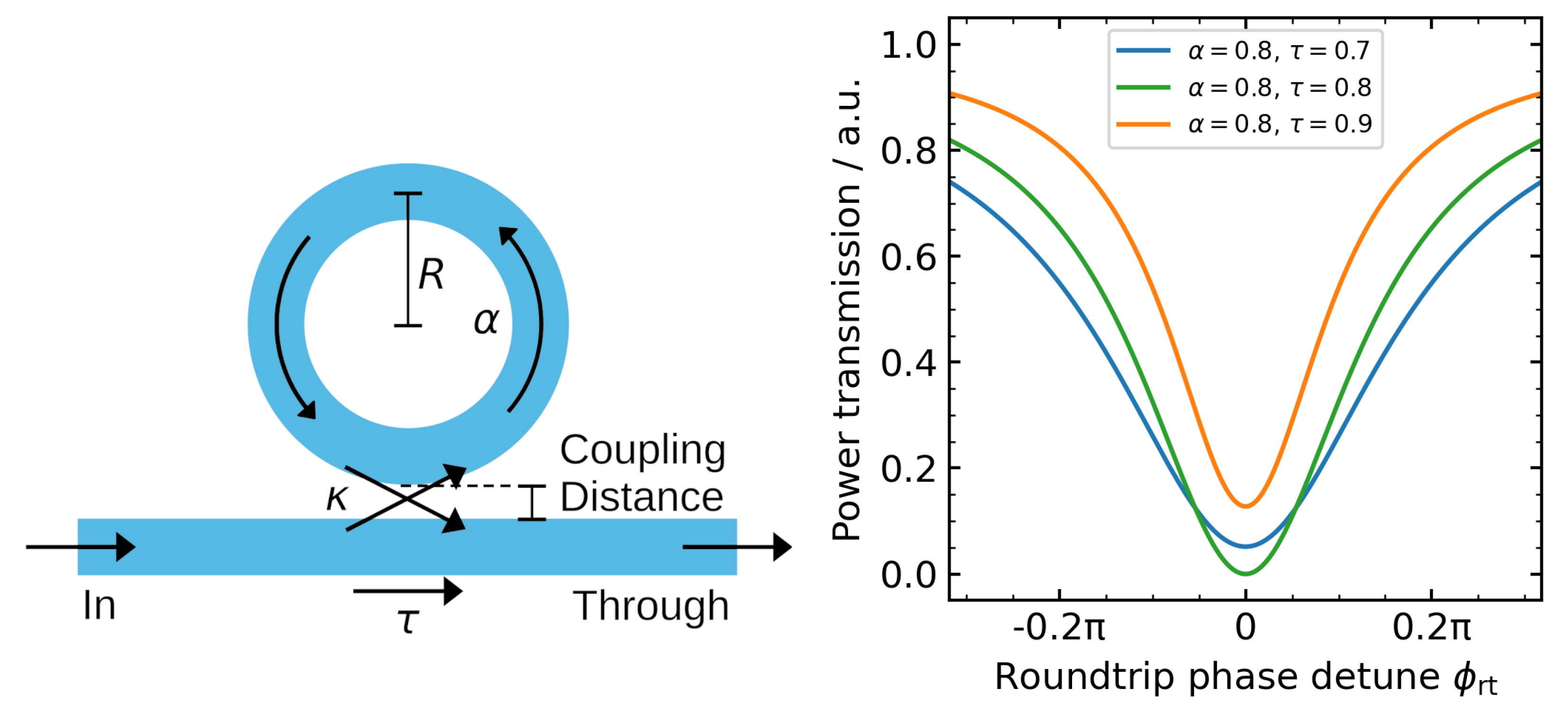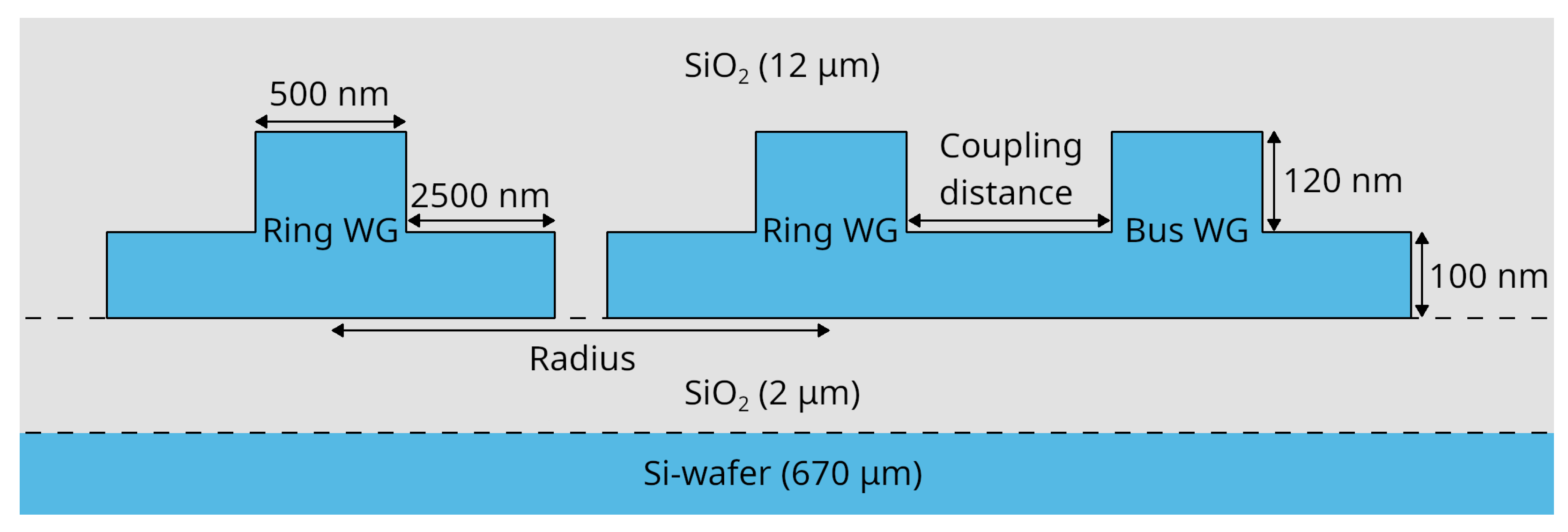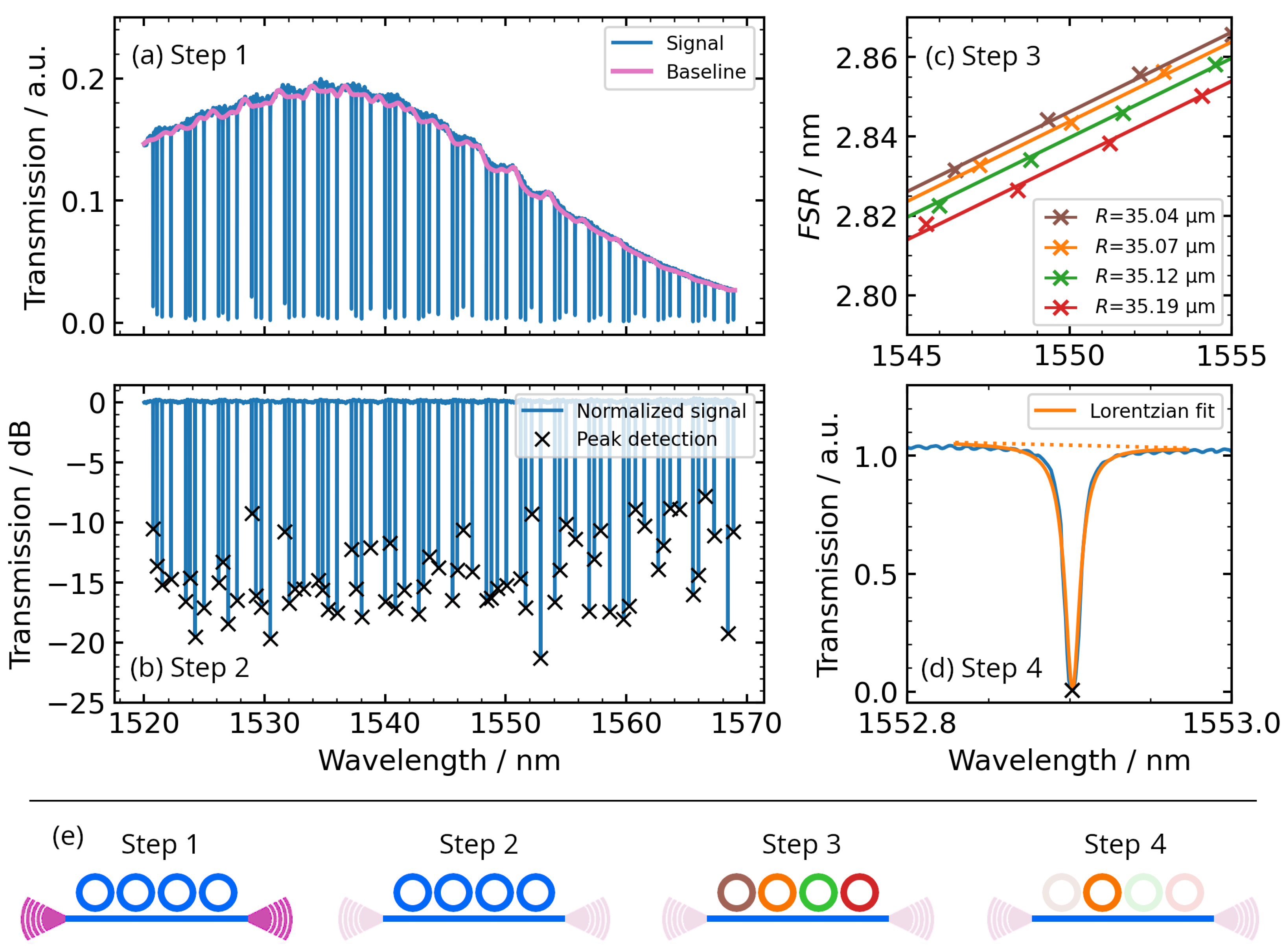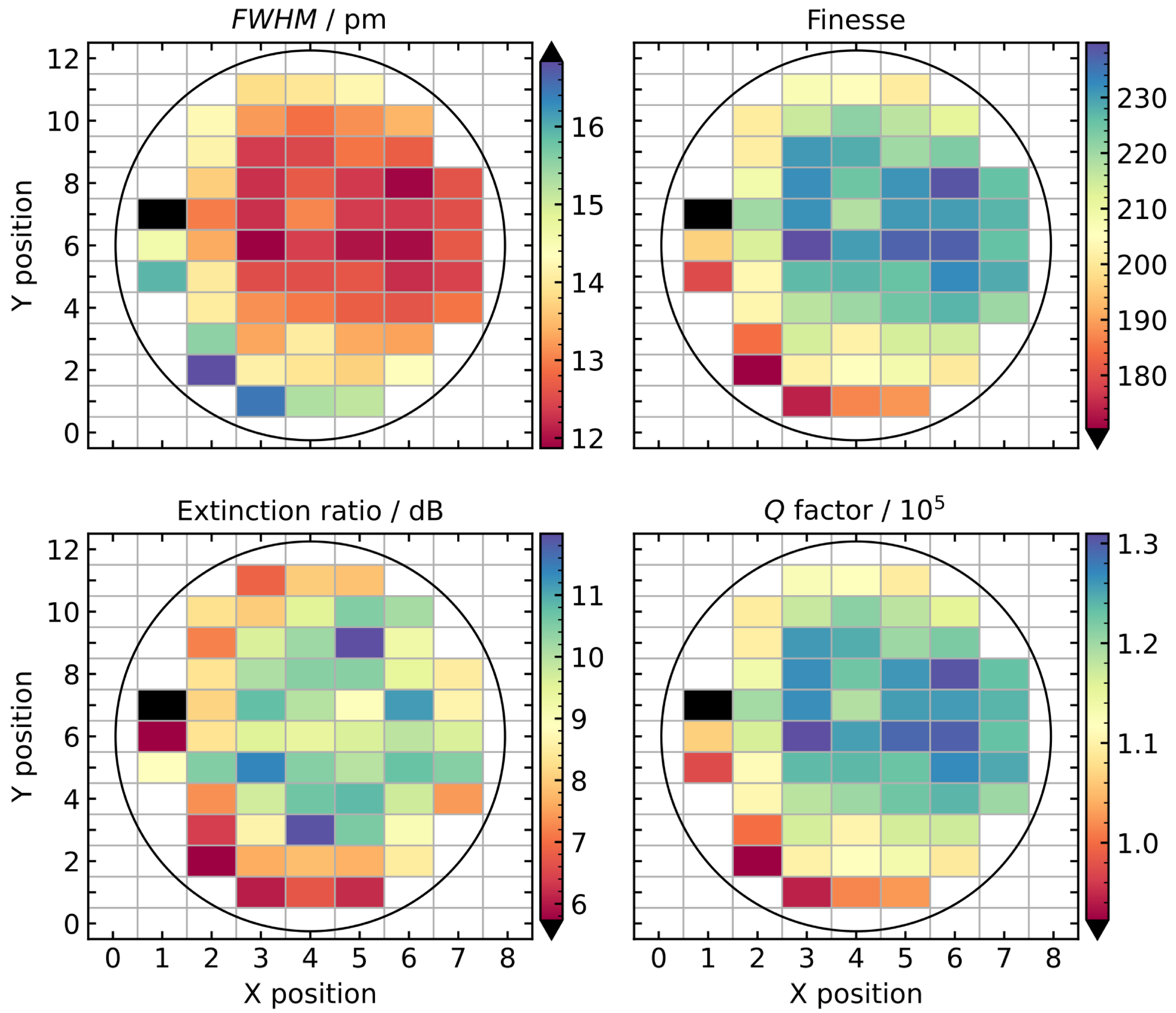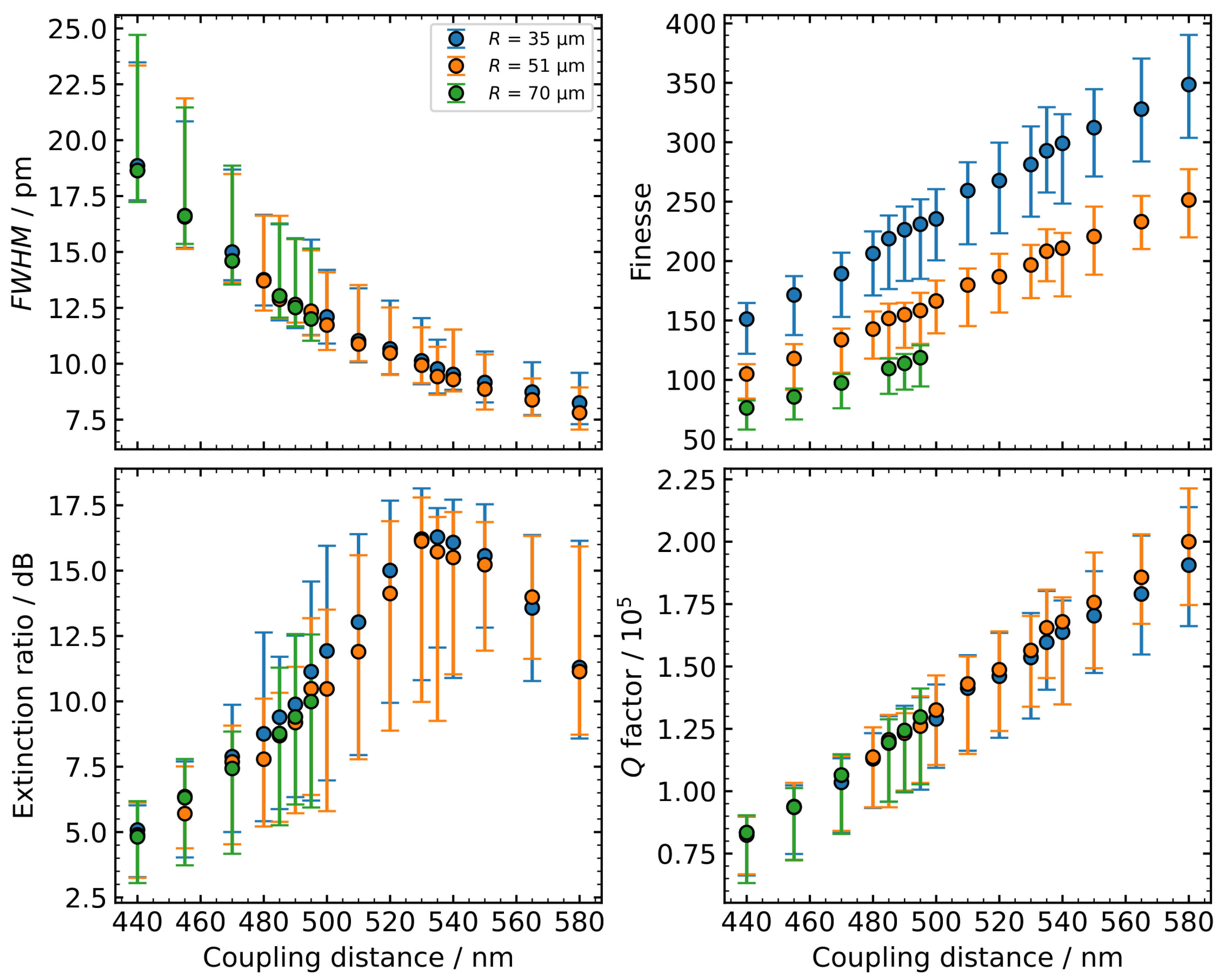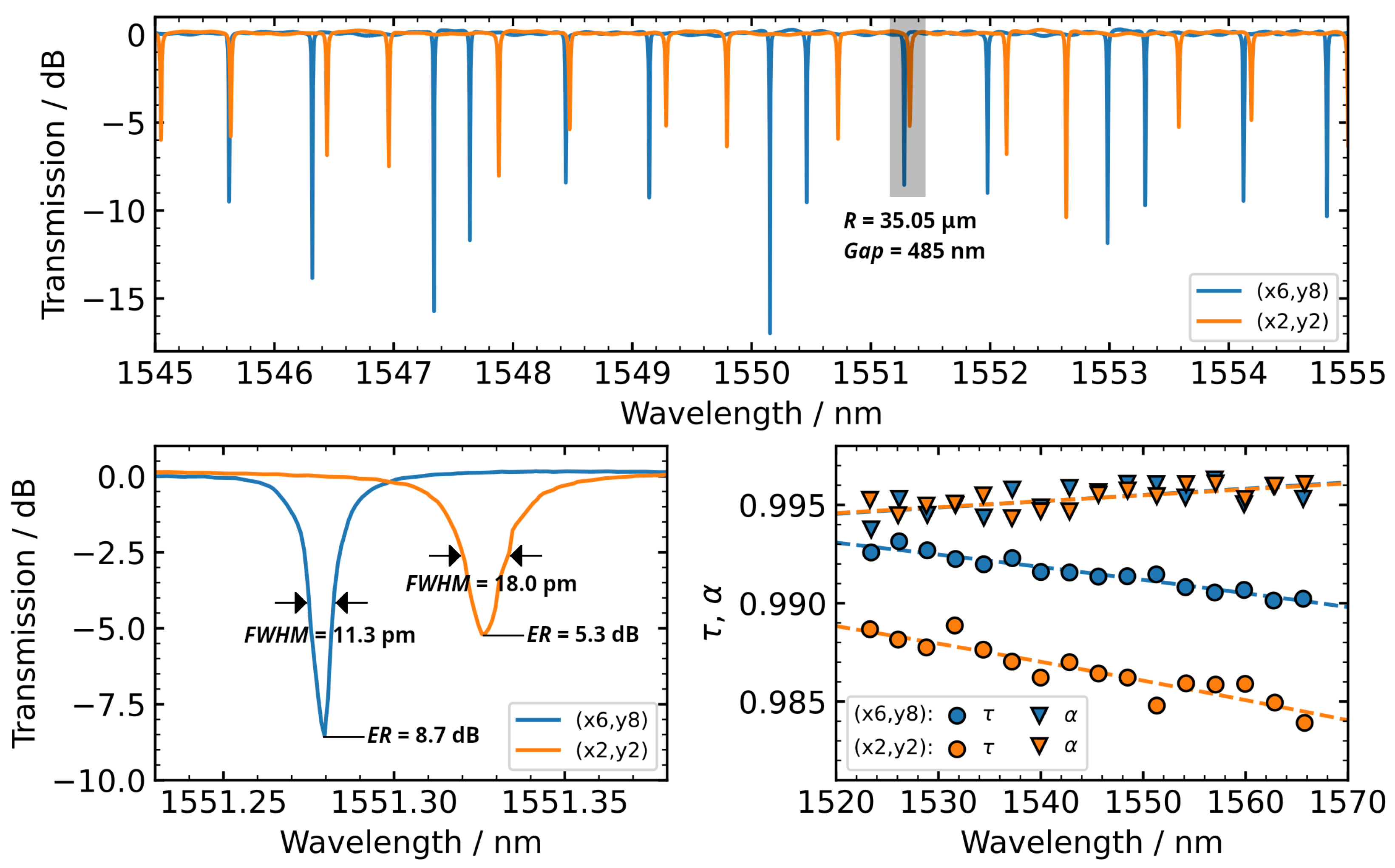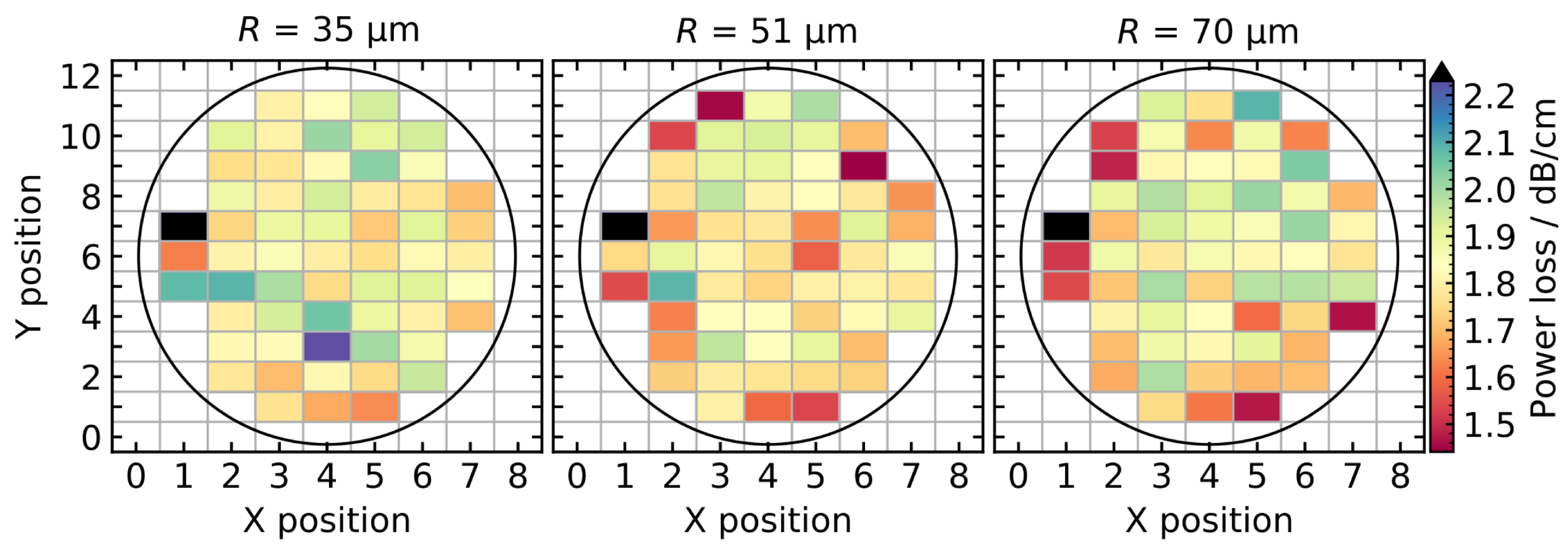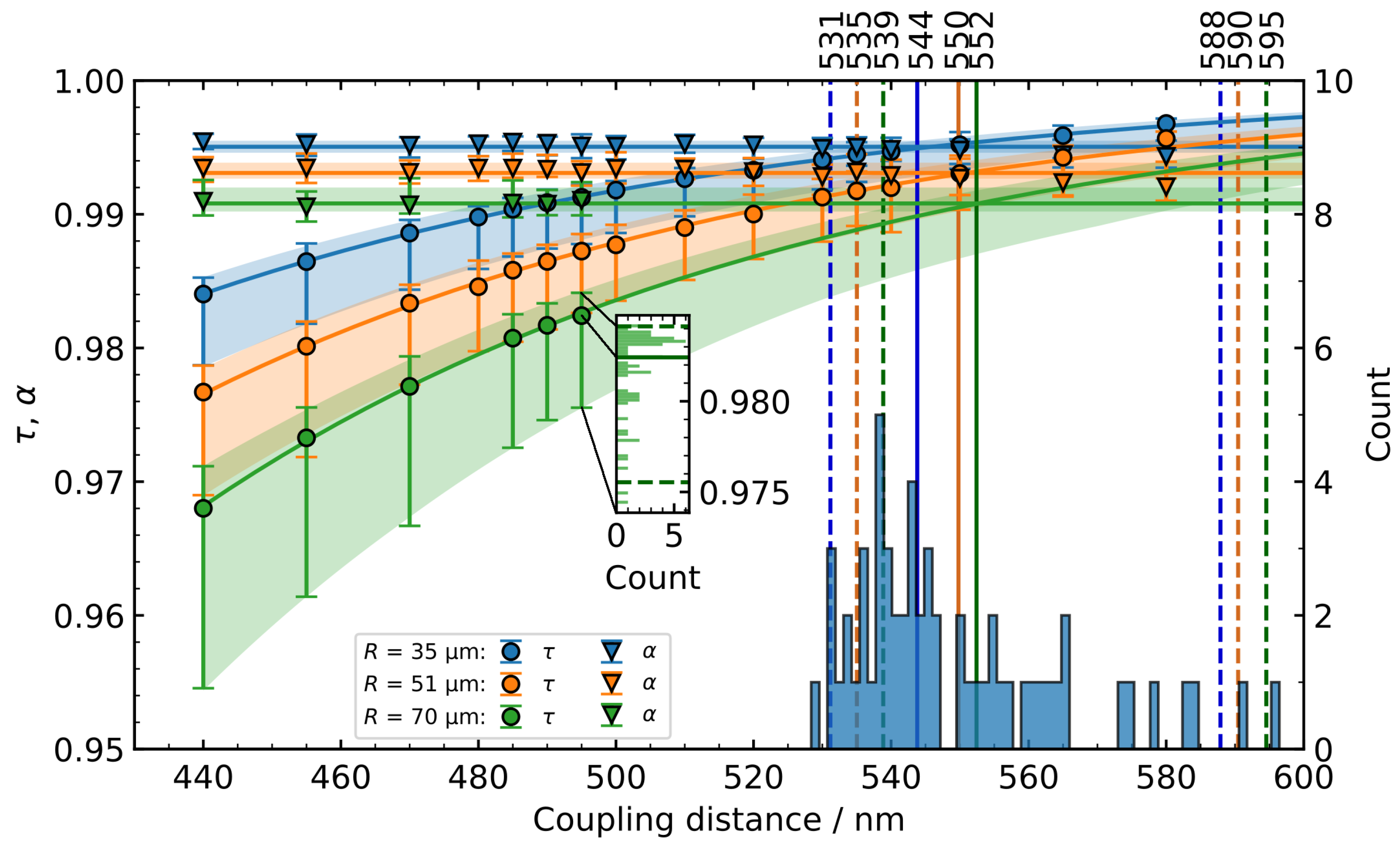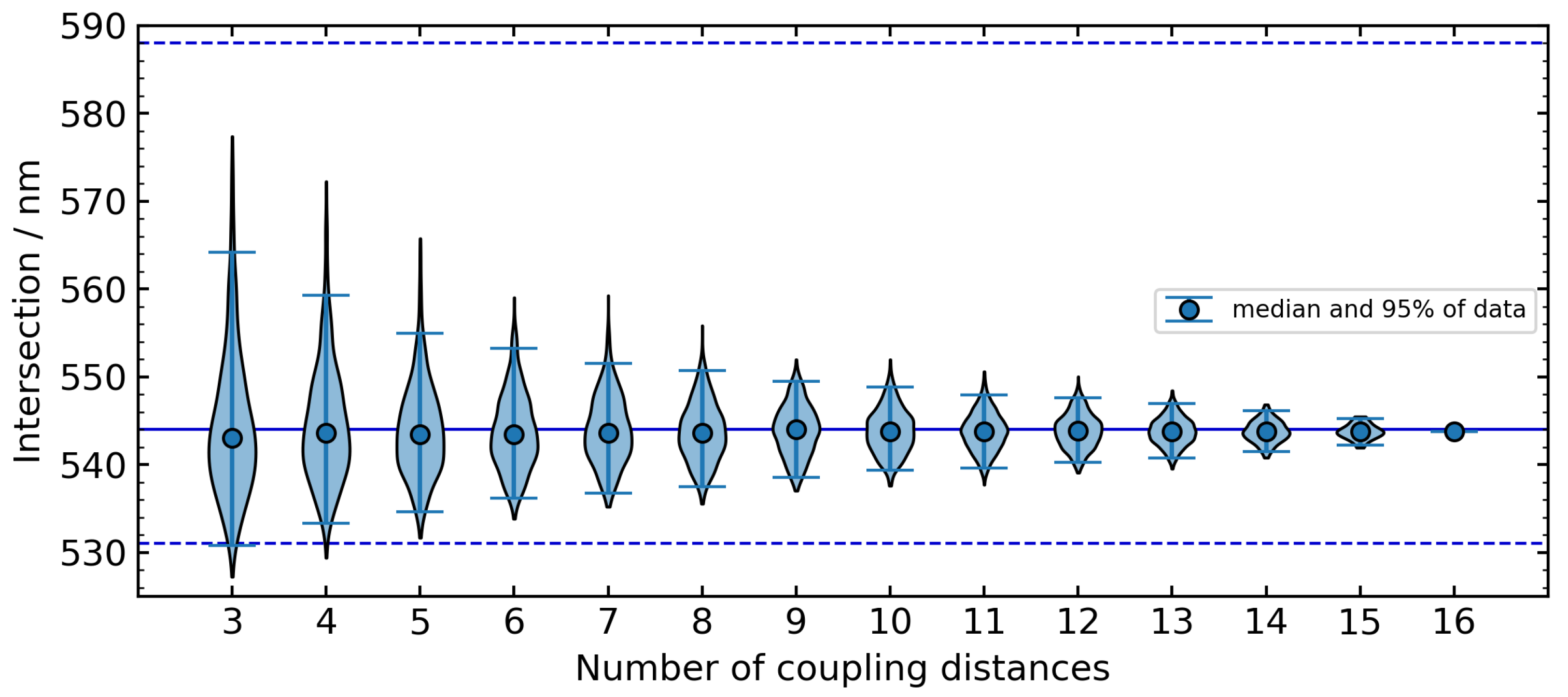3.1. Experimental Setup and Data Processing
The measurements were performed using an automated wafer prober. A tunable laser (Keysight 81608A) was used as a source in combination with a Keysight N7745A photodiode. Recorded spectra spanned from 1520 nm to 1570 nm with a wavelength step size of 1 pm. Polarization was optimized using a Thorlabs FPC032 fiber polarization controller. Parallel to the photonic circuits, a reference gas cell (H
13C
14N) was probed to perform an in situ wavelength calibration. Next to a description of an experimental setup used for interrogating single chips, details on the calibration routine can be found in [
15]. From 59 chips of a 200 mm wafer, a total of 2242 all-pass silicon ring resonators were probed. These 59 nominally identical photonic chips were manufactured on a multi-project wafer using IHP’s SG25H5_EPIC technology [
16,
17]. The waveguide geometry is a rib design in which the 220 nm high silicon is completely surrounded by silicon dioxide as depicted in
Figure 2. Each photonic circuit consists of grating couplers that realize the fiber-to-chip coupling and multiple ring resonators which are serially coupled to the same bus waveguide (see
Figure 3e). Three different ring radii of approximately 35 µm, 51 µm, and 70 µm were realized on each chip, with coupling distances ranging from 440 nm to 580 nm.
To effectively extract essential properties from the measured spectra, we implemented post-processing as follows.
Figure 3a shows the spectrum of four serially coupled resonators with 35 µm radii with coupling distances from 510 nm to 540 nm. To compensate for the transfer function of the grating couplers, each spectrum was normalized to a baseline fitted with a low-pass filter (
Figure 3a). After this, a simple peak detection of the normalized spectra is performed (
Figure 3b). By design, each serially coupled resonator (coupled to the same bus waveguide) has a slightly different radius to ensure unique assignment of resonances and corresponding coupling distance by means of small differences in the free spectral range (
,
Figure 3c). We thereby assign the
to each resonant wavelength as the necessary positive wavelength shift to obtain a round-trip phase shift of
[
5]. For each determined peak, a lorentzian fit function (with linear background) is utilized (
Figure 3d). From the lorentzian fit, we can immediately extract the resonance wavelength, the full width at half minimum, and the maximum and minimum transmission.
3.2. Wafer-Scale Optical Properties of Ring Resonators
Using the data extracted from the Lorentzian fit, we are able to determine the optical properties finesse, extinction ratio, and
Q factor of all ring resonators at wafer-scale.
Figure 4 exemplarily shows the results for ring resonators with a radius of 35 µm and a coupling distance of 485 nm. The color map represents the average value in the wavelength range from 1540 nm to 1560 nm, containing approximately 6 (
µm), 10 (
µm), or 20 (
µm) resonances. The die at position
,
is considered an outlier and is not incorporated in the following evaluations.
In a first approximation, the optical properties show a radial spatial distribution over the wafer. Clearly, the central and right section of the wafer show a higher extinction ratio,
Q factor, and finesse, and a smaller
compared to the outer left part of the wafer. Inhomogeneous spatial distribution of material properties over a wafer is a common phenomenon related to multiple aspects of fabrication processes [
11,
18]. Reported spatial dependencies include refractive indices [
19] and waveguide geometry [
11,
20].
Taking into account the dependence on the coupling distance, we can exploit our parameter sweep and present wafer-scale evaluation for each coupling distance in
Figure 5.
, finesse, and
Q factor show monotonic behaviour depending on the coupling distance, whereas for resonators with radius of 35 µm and 51 µm, we can observe peak extinction ratios at coupling distances around 535 nm. For resonators with a radius of 70 µm, we have a smaller set of coupling distances ranging from 440 nm to 495 µm and that do not cross coupling regimes. For all of these properties, the variation across the wafer (whiskers in
Figure 5) is asymmetric, reflecting the greater number of dies with properties close to the median in the central region of the wafer. With the exception of the extinction ratio, the span of variation is clearly dependent on the median, resulting in an almost constant relative variation.
Figure 5 also shows that
,
Q factor, and extinction ratios barely depend on the ring radius. Only the finesse has the expected radius dependence, resulting from the different values of the free spectral range.
Beyond the applied approach of averaging optical properties over the wavelengths from 1540 nm to 1560 nm, we can report the highest
of measured
Q factors for resonators with
µm to be within a range from 213,000 to 273,000 and the highest
values for the extinction ratio to be within a range from 18.9 dB to 26.1 dB. The extinction ratio is maximised at coupling distances where critical coupling is achieved and only limited by stray light [
9]. In contrast, the
Q factor is limited by the investigated range of coupling distances. At the cost of a lower extinction ratio, achieving higher
Q factors would be possible with larger coupling distances.
3.3. Coupling and Loss
In the following, intra-wafer variations of coupling and loss and the effect of varying coupling distances on coupling coefficients are determined experimentally. As described in
Section 2, the difference in resonance spectra (e.g., extinction ratio and 3 dB bandwidth) of nominally identical resonators from different dies on the wafer can be explained by their coupling and loss coefficients.
Figure 6 shows a clear example of these differences for nominally identical resonators with
µm and coupling distance of 485 nm from a chip near the centre of the wafer (position
,
, refer to
Figure 4) and one from the edge (position
,
). The center wavelength of the resonances differs between the two dies due to different optical path lengths. These variations extend over at least the free spectral range, and therefore quantification is unfeasible without knowledge of the resonance order. The coupling and loss coefficients shown in
Figure 6 over a range of 50 nm are extracted as described in
Section 2. The loss coefficient does not differ and the reason for the different shapes of the resonance spectra is due to different coupling strengths. For interpolation, fit functions [
9] with free parameters
to
are used:
By applying the formalism from
Section 2 to the processed data of the 59 nominally identical chips (see sections above), we can calculate wafer maps for coupling and loss coefficients as depicted in
Figure 7. As these coefficients are wavelength dependent, we utilize the values of the fit functions (see
Figure 6 bottom right) at
nm as a reference value. The values in
Figure 7 are normalised to the median of all 59 dies to show their relative variations (for the loss coefficient, the die at position
,
is an outlier and is not included). At wafer-scale, the coupling coefficient
varies more strongly than the loss coefficient
, as already observed for two dies in
Figure 6. Moreover, in a first approximation, the loss coefficient is randomly distributed over the wafer, whereas the coupling coefficient shows radial dependence with weaker coupling around the center and stronger coupling towards the edges of the wafer. It can thus be deduced that the intra-wafer variations of optical properties found in
Section 3.2 are mainly caused by variations in coupling strength.
As a benchmark, we compare the loss values calculated above with the waveguide loss of approximately 1.5 dB/cm obtained from test structures on the same wafer. A total of 95% of the losses deduced from
are in the range from 1.78 dB/cm to 2.14 dB/cm (
µm), 1.66 dB/cm to 1.99 dB/cm (
µm), and 1.59 dB/cm to 1.94 dB/cm (
µm), which is in good agreement with the standard waveguide loss. As in Equation (
2) we assumed loss-free coupling,
includes waveguide propagation losses, bending losses, and coupling losses [
6], and as such is expected to be slightly higher. The distribution of losses in dB/cm over the wafer can be found in
Figure 8.
In
Figure 9, we analyse the coupling and loss coefficients as a function of coupling distance to determine the coupling distance at which critical coupling (
) occurs. The coefficients of resonators with radii of 35 µm, 51 µm, and 70 µm from 58 dies are represented by the median (dots, triangles) and 95% span (whiskers). The green histogram shows the underlying distribution of coupling coefficients for resonators of 70 µm radius at a coupling distance of 490 nm as an example, reflecting the distribution from
Figure 7.
To derive a coupling distance that realises critical coupling, we incorporated two fitting functions for the coefficients and determined the distance at which they intersected. As for the loss coefficient, we did not find a clear dependence on the coupling distance; thus, we used a constant function. For the coupling coefficient, we utilized the following expression with the coupling distance
g and parameters
and
:
Applying these fits to resonators from 58 dies, we obtained an asymmetrical distributed set of fit functions representing the individual coupling and loss coefficients (median depicted as colored line and 95% span as areas in
Figure 9). The resulting distribution of intersection points where
, representing the optimal coupling distances for critical coupling, is shown for resonators of 35 µm radius in the blue histogram in
Figure 9. From these distributions of the three radii, the median (solid lines) and the 95% range (dashed lines) were calculated, and their values are shown at the top of the graph. A total of
of coupling distances that realized critical coupling are within a range from 531 nm to 588 nm (
µm), 535 nm to 590 nm (
µm), and 543 nm to 601 nm (
µm).
Figure 9 also shows that both
and
depend on the radius of the resonator. The loss inside the ring waveguide accumulates over its length and the coupling region increases with an increasing radius. For resonators with a radius of approximately 70 µm, critical coupling was not reached within the given range of coupling distances. Nonetheless, curve fitting allows for extrapolation to infer a coupling distance at which
. The ability to predict values for
and
outside of the realized parameter range is further investigated in the following
Section 3.4.
3.4. Prediction of Coupling Coefficients from a Reduced Set of Parameters
The ability to predict values for
and
outside of a realized parameter range is beneficial for optimizing the performance of resonators based on a small set of test structures. It should be noted that one can also use the extinction ratio versus the coupling distance as a measure to infer the coupling regime (critically coupled, under, or overcoupled), as it shows non-monotinic behaviour. Practically, this is only possible if the investigated set of coupling distances does incorporate the transition between the mentioned regimes. As demonstrated in
Section 3.3 (see
Figure 9), the utilization of fit functions for coupling and loss coefficients depending on the coupling distance allows for extrapolation, regardless of whether the set of investigated coupling distances spans over the different regimes.
To investigate this method quantitatively, we chose the resonators with radii of approximately 35 µm on the chip that has its intersection point of
and
closest to the median of all intersection points (and is the central chip on the wafer at position
,
). For a given number of coupling distances (see
Figure 10), we draw all possible combinations of coupling distance values
g, or 1000 unique random combinations if the set of possible combinations exceeds 1000. For these parameter sets, curve fitting is used (
constant and
from Equation (
11)) to obtain values for the coupling distances where
.
Figure 10 shows the results as a violin plot, using a Gaussian kernel density estimation to represent the underlying distribution. The whiskers contain
of the data. These results are compared to the median (solid line) and
interval (dashed lines) of intersection points introduced in
Figure 9 from wafer-scale statistics.
As expected, the results converge as the number of coupling distance values used for the prediction of the critical coupling distance increases. According to our results, even for only three coupling distances, of the predicted values are within the interval derived from the wafer-scale statistics. This means that this prediction accuracy may already be sufficient, as it is within the variation on wafer level. Of course, coupling distances that are spread more evenly over the investigated range will give more accurate predictions, and values far away from critical coupling will lead to less accurate predictions. However, the results suggest that with a coarse simulation as a starting point, a small number of coupling distance test parameters may be sufficient to predict coupling coefficients and optimise design parameters.
